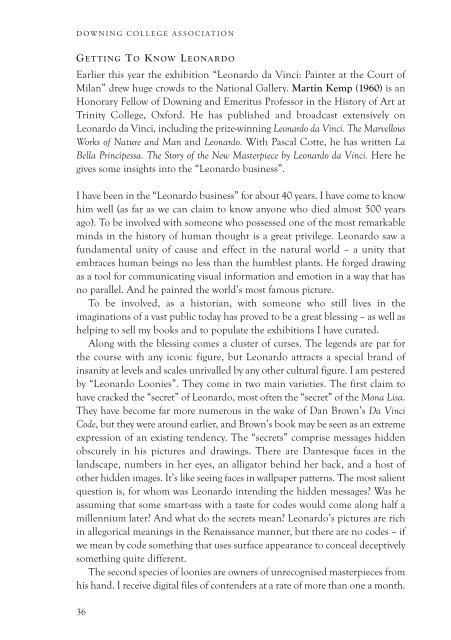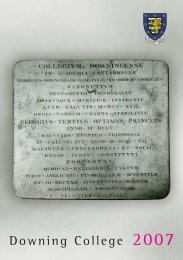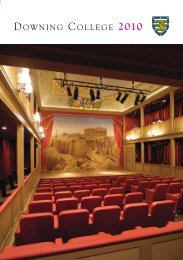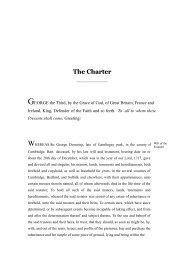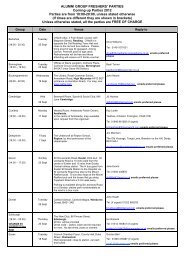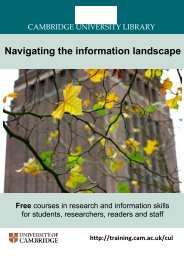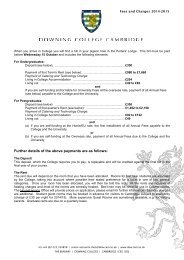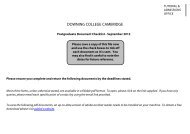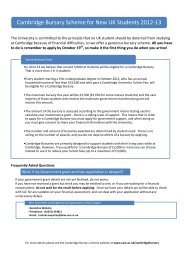downing text 2012_Layout 1 - Downing College - University of ...
downing text 2012_Layout 1 - Downing College - University of ...
downing text 2012_Layout 1 - Downing College - University of ...
- No tags were found...
Create successful ePaper yourself
Turn your PDF publications into a flip-book with our unique Google optimized e-Paper software.
DOWNING COLLEGE ASSOCIATIONG ETTING T O K NOW L EONARDOEarlier this year the exhibition “Leonardo da Vinci: Painter at the Court <strong>of</strong>Milan” drew huge crowds to the National Gallery. Martin Kemp (1960) is anHonorary Fellow <strong>of</strong> <strong>Downing</strong> and Emeritus Pr<strong>of</strong>essor in the History <strong>of</strong> Art atTrinity <strong>College</strong>, Oxford. He has published and broadcast extensively onLeonardo da Vinci, including the prize-winning Leonardo da Vinci. The MarvellousWorks <strong>of</strong> Nature and Man and Leonardo. With Pascal Cotte, he has written LaBella Principessa. The Story <strong>of</strong> the New Masterpiece by Leonardo da Vinci. Here hegives some insights into the “Leonardo business”.I have been in the “Leonardo business” for about 40 years. I have come to knowhim well (as far as we can claim to know anyone who died almost 500 yearsago). To be involved with someone who possessed one <strong>of</strong> the most remarkableminds in the history <strong>of</strong> human thought is a great privilege. Leonardo saw afundamental unity <strong>of</strong> cause and effect in the natural world – a unity thatembraces human beings no less than the humblest plants. He forged drawingas a tool for communicating visual information and emotion in a way that hasno parallel. And he painted the world’s most famous picture.To be involved, as a historian, with someone who still lives in theimaginations <strong>of</strong> a vast public today has proved to be a great blessing – as well ashelping to sell my books and to populate the exhibitions I have curated.Along with the blessing comes a cluster <strong>of</strong> curses. The legends are par forthe course with any iconic figure, but Leonardo attracts a special brand <strong>of</strong>insanity at levels and scales unrivalled by any other cultural figure. I am pesteredby “Leonardo Loonies”. They come in two main varieties. The first claim tohave cracked the “secret” <strong>of</strong> Leonardo, most <strong>of</strong>ten the “secret” <strong>of</strong> the Mona Lisa.They have become far more numerous in the wake <strong>of</strong> Dan Brown’s Da VinciCode, but they were around earlier, and Brown’s book may be seen as an extremeexpression <strong>of</strong> an existing tendency. The “secrets” comprise messages hiddenobscurely in his pictures and drawings. There are Dantesque faces in thelandscape, numbers in her eyes, an alligator behind her back, and a host <strong>of</strong>other hidden images. It’s like seeing faces in wallpaper patterns. The most salientquestion is, for whom was Leonardo intending the hidden messages? Was heassuming that some smart-ass with a taste for codes would come along half amillennium later? And what do the secrets mean? Leonardo’s pictures are richin allegorical meanings in the Renaissance manner, but there are no codes – ifwe mean by code something that uses surface appearance to conceal deceptivelysomething quite different.The second species <strong>of</strong> loonies are owners <strong>of</strong> unrecognised masterpieces fromhis hand. I receive digital files <strong>of</strong> contenders at a rate <strong>of</strong> more than one a month.36


